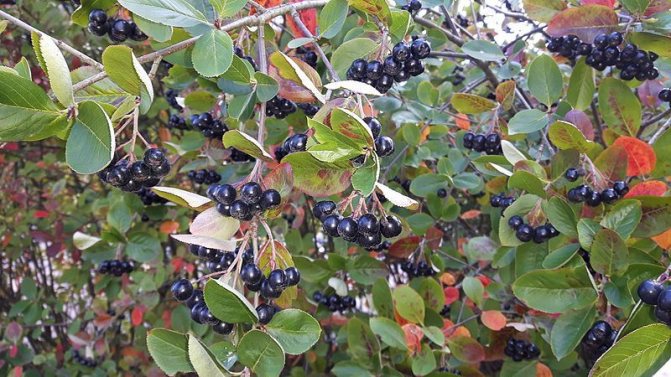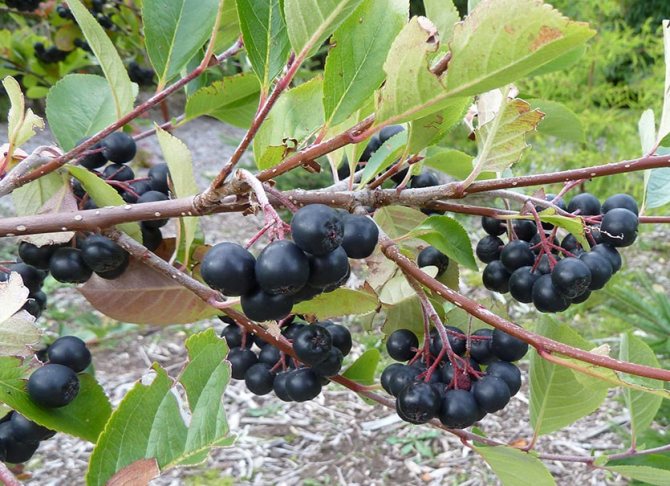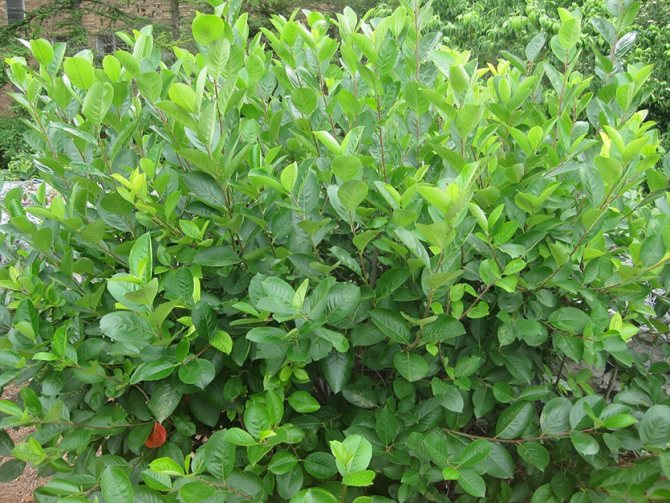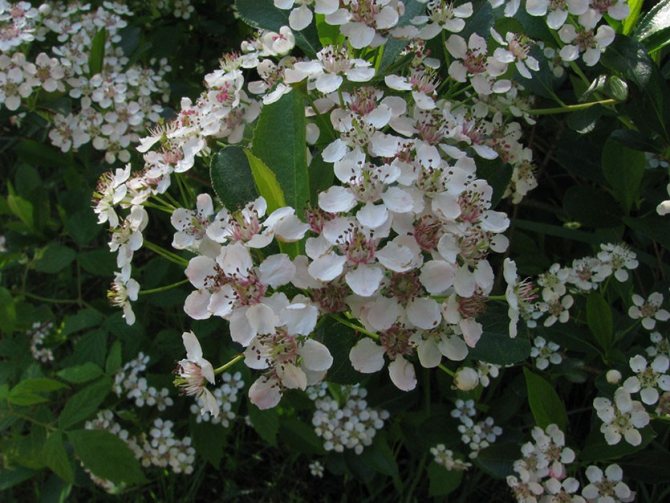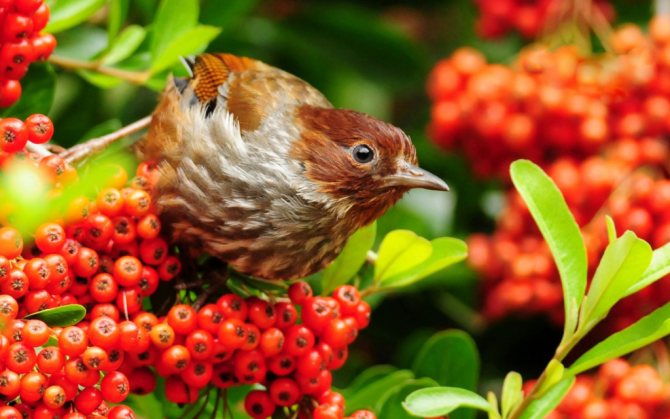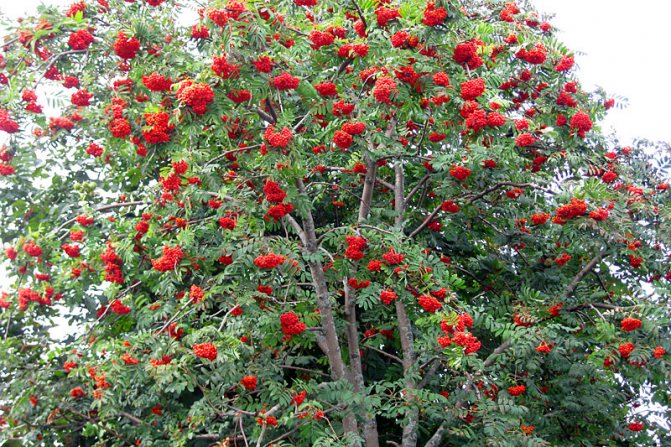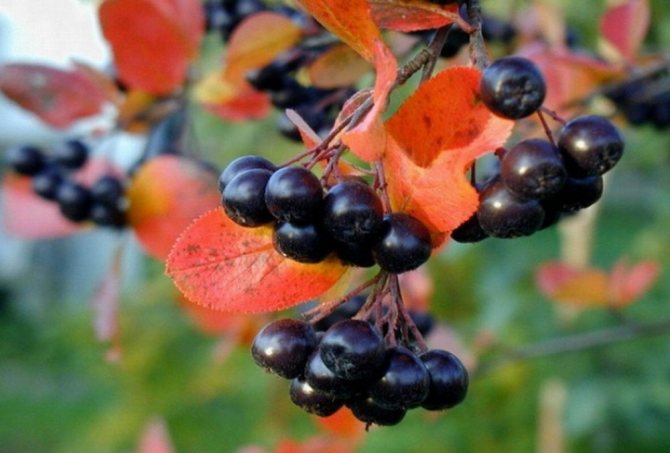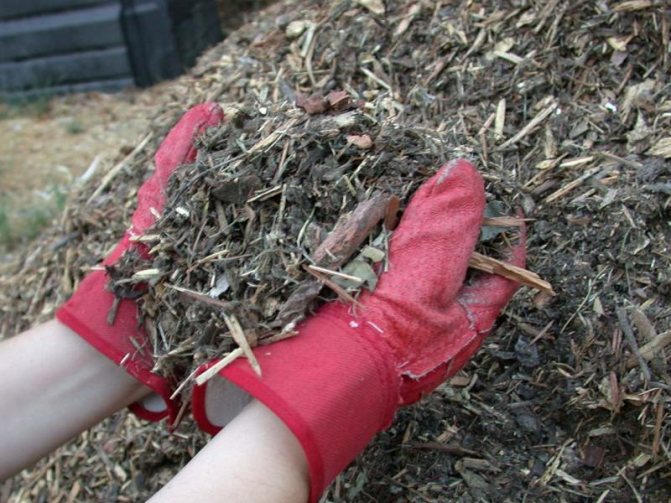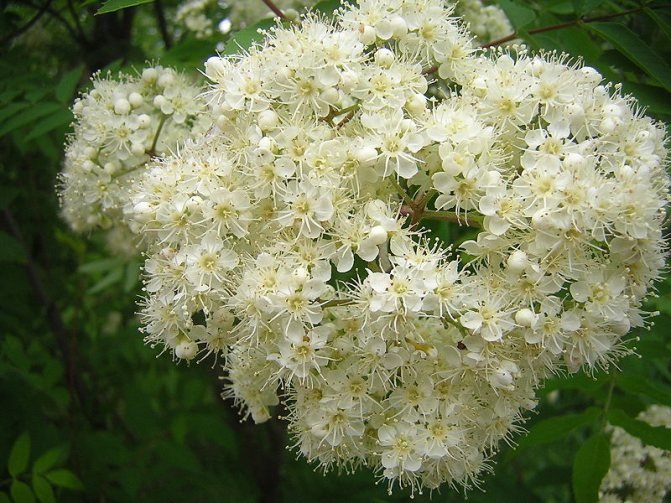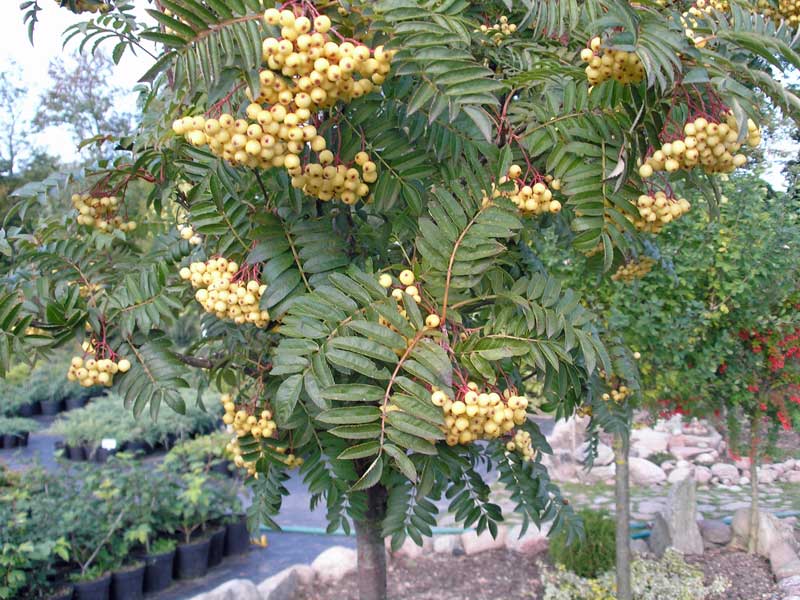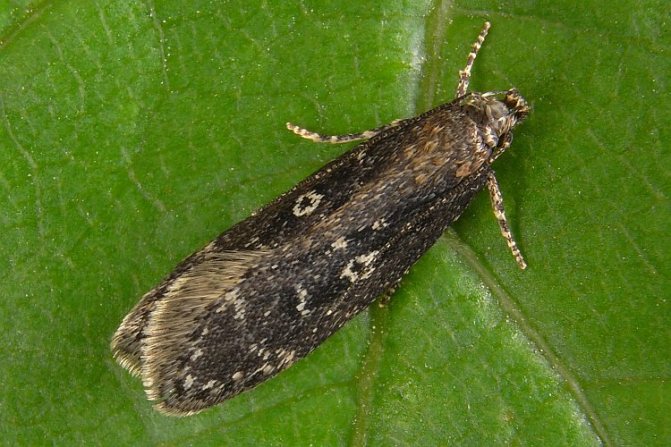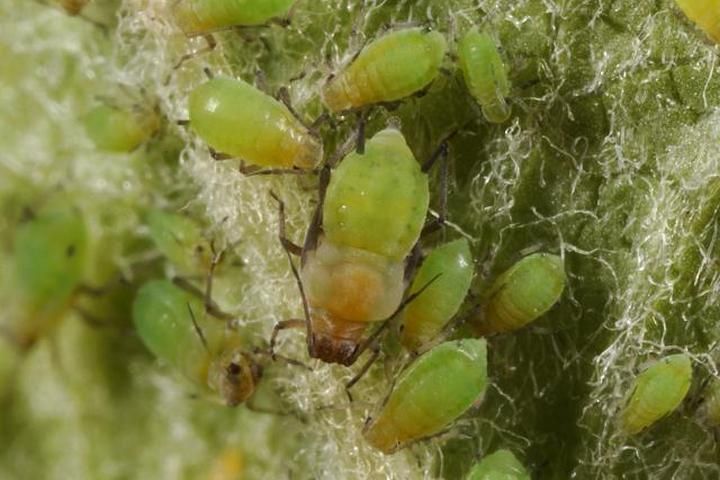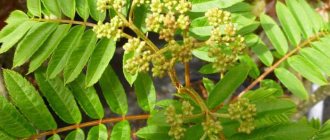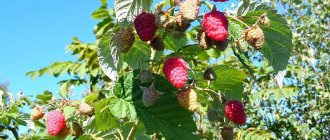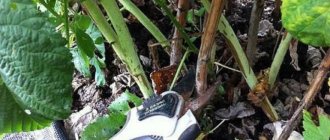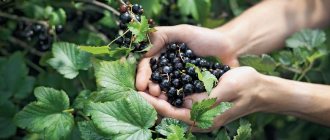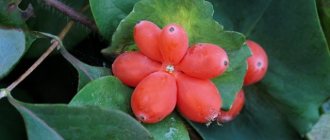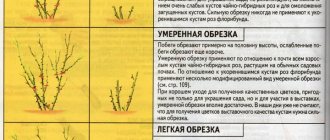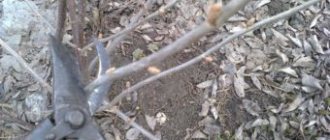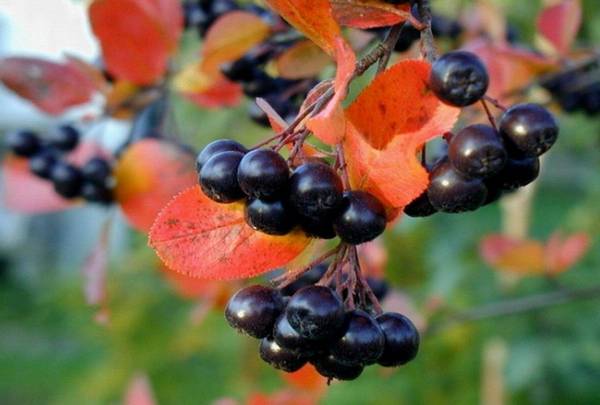
TOOLS REQUIRED
Saw
Pruner Expand
For the correct formation of a young plant or for the purpose of cultivating an adult bush, timely and correct pruning of chokeberry is necessary. Simple care rules will help not only maintain the decorative effect of the shrub, but also get a generous harvest of healthy and tasty berries.
Information and description of agricultural technology
Chokeberry was obtained as a result of an experiment, during which scientists crossed the mountain ash and black chokeberry. Aronia grows in sandy plains, marshlands, and the mountain slopes of the United States. The tree-like shrub is undersized and unsightly, different from the chokeberry that is grown in our time.
In Russia, the bush was cultivated by the famous Russian breeder I. V. Michurin. Since the variety is resistant to various diseases and winter-hardy, it has taken one of the leading positions in a vast territory, including the north-west of Russia, Siberia and the Urals. This plant is grown in almost any climatic conditions.
Note! To get a good harvest, the land must be well lit. The shade reduces the yield and does not have the best effect on the presentation of the fruit.
The chokeberry will feel great in the lowlands, where groundwater is at a level of 2 m.This is due to the fact that the root system of the culture when planting is submerged shallowly - up to 1 m.If there is not enough moisture near the roots, this will lead to a decrease in productivity and winter hardiness ... Different types of soil are suitable for growing black chokeberry, namely:
- gray forest;
- black soil;
- sod-podzolic;
- drained peatlands.


Chokeberry tree
It is not recommended to grow mountain ash on swampy, saline and rocky areas of the land. The plant is planted by gardeners as a combined hedge, as well as to decorate spacious areas. The shrub strengthens the ravines or perimeter of household plots, which are located near water bodies or cliffs.
Councils to gardeners.
If the mountain ash has stopped growing, then in the spring, before the start of sap flow, the top of the crown should be partially cut off. This pruning will encourage the growth of the side branches. In addition, you need to prevent the tree from forming inflorescences and fruits, so that all the nutrients are directed to its growth.
In some cases, regular feeding does not bring the expected effect. This can happen when the tree has a weak root. Experts recommend, if possible, dig up the tree and cut off part of the root. After that, the roots will begin to grow, and a powerful and branched root system will be able to absorb a larger amount of essential nutrients and elements.
If there is a need, on the contrary, to stop the active growth of the tree, then it is enough to carry out summer pruning of mountain ash.
In the spring, pruning of mountain ash, like other fruit trees, is carried out strictly before the onset of sap flow and swelling of the buds.
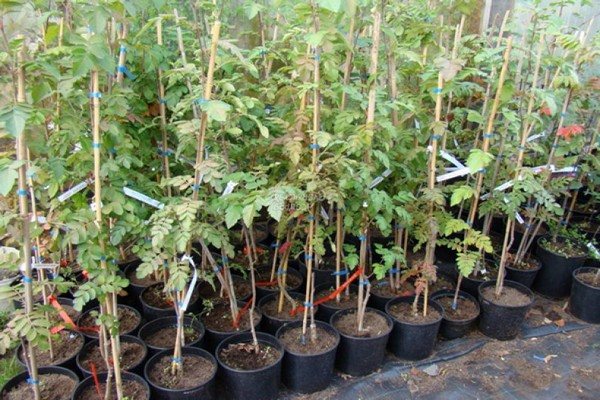

How to propagate chokeberry
This variety of mountain ash can be propagated by both vegetative and seed methods, any one ensures the preservation of varietal characteristics and characteristics of the mother culture. Experienced gardeners recommend propagating mountain ash using the seed method or green cuttings.


Propagation by cuttings
Actinidia: growing and care
To propagate chokeberry by means of green cuttings, you must first familiarize yourself with the rules for dividing cuttings and creating conditions for early rooting.
Attention! The propagation of mountain ash by cuttings involves the presence of a cold greenhouse and the preparation of special soil, which will require wood ash and garden soil.
The length of cuttings cut from a young tree should be no more than 15 cm.All foliage must be removed from the lower part. On the surface of the bark, make 2 incisions from the bottom, as well as 1 incision in the upper part, under the kidneys.
Before planting chokeberry, it must be treated with a stimulant in order for the roots to form: lower the lower part of the cuttings into the solution of the product and hold for at least 8 hours. After that, the plant can be planted in greenhouses, maintaining a distance of 4 cm between seedlings. The final stage will be abundant watering of the soil and covering the greenhouse with a film, which will need to be opened after 3 months.
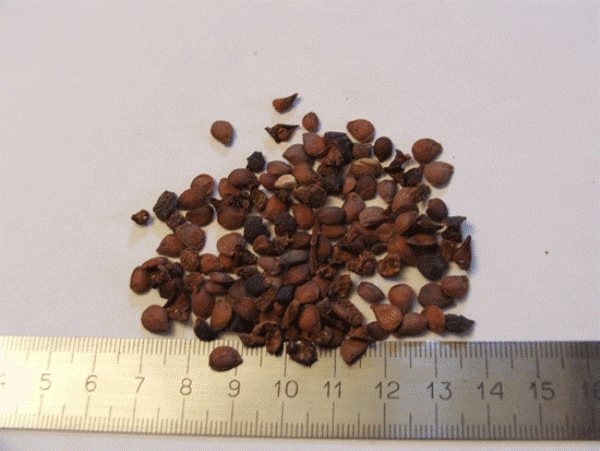

Rowan seeds
For seed propagation of chokeberry, it is necessary to obtain plant seeds. Rowan fruits must be rubbed through a sieve and rinsed in water, separating the pulp. To ensure high germination rates, chokeberry seeds need stratification. Reproduction of a plant by this method takes place in several stages:
- The sand must be calcined and mixed with the seeds, then put on the bottom shelf of the refrigerator for 90 days. Be sure to moisturize the sand throughout this time.
- In the second half of April, you can plant seeds in open ground. You need to choose a suitable site and make holes on it 8 cm deep, then sow the planting material and cover it with earth. Mulch the plantation using humus.
The seedlings will grow a little and the next autumn they can be transplanted and grafted, and before that, care should be provided, including systematic watering, loosening and feeding, which is usually used as slurry.
Attention! When the first leaves appear in the seedlings, they need to be thinned out and only those that seem strong should be left. The distance between the leaves should be 3 cm.
After the next 5 leaves appear, they must be thinned again, maintaining a distance of 6 cm between the seedlings. With the onset of next spring, the seedlings need to be thinned out with a distance of 15 cm, otherwise they will not bloom.
Errors made during trimming.
Among the most common mistakes made when pruning mountain ash, first of all, one should indicate not the removal of branches that grow at an acute angle. Leaving such shoots is fraught with serious injury to the tree.
Also, quite often, in addition to the central conductor, several more large parallel growing branches are left. Competing with the main trunk, such branches take up a significant amount of food, which negatively affects the growth and development of the tree as a whole. The optimal number of main vertical shoots on a bush should be no more than 3 or 5.
It is not always correct to make a cut and carry out its processing. Thus, a correct cut assumes a smooth surface. In this case, it tightens much faster, and, thereby, the likelihood of penetration of pathogenic microorganisms into the wound is reduced. Therefore, to carry out trimming, you need to stock up on various well-sharpened tools. Small branches can be removed with a pruner, larger ones need to be cut down with a garden saw or hacksaw.Very thick and large branches, right, first, saw off from below, and then, finish off from above. This method will prevent the formation of bark chips and scuffing of branches.
It is also important that the cut relative to the roots of the tree is made at a 45 degree angle.
Also, immediately after cutting the branch, it is necessary to process the cut point. In addition to garden varnish and paint, you can also use special ointments such as Funaben 03 PA. This drug already contains a systemic fungicide and significantly accelerates the healing of slices.
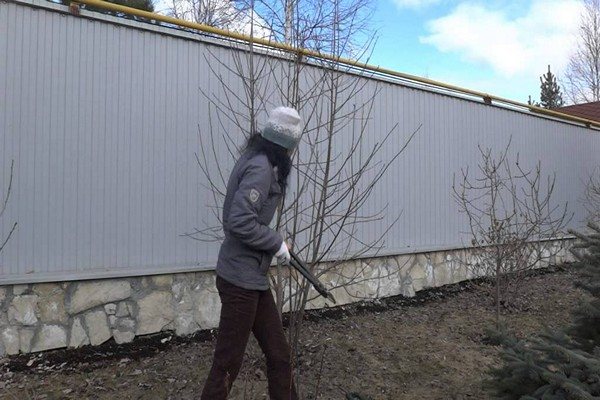

How to choose the right chokeberry seedlings
Leeks - growing and care
To date, breeders have bred various varieties and hybrids of chokeberry, Viking, Rubina, Hakkia, Kutno and Chernookaya are popular. They are very similar in appearance, but differ only in terms of fruiting and taste. The main criterion for choosing planting material is the climatic conditions of the proposed growing region.
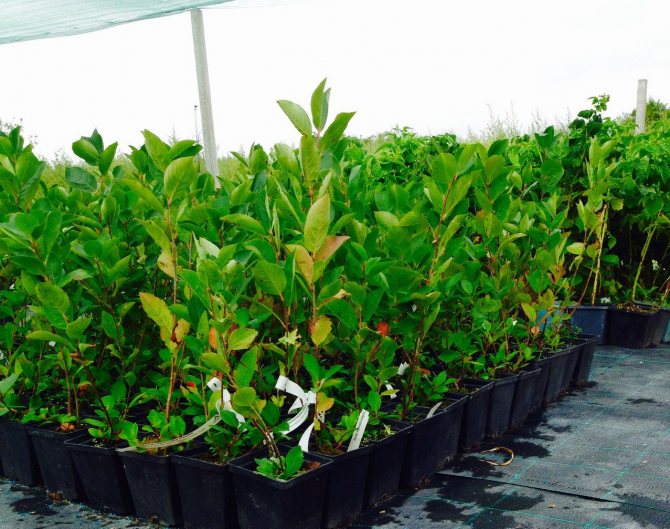

Chokeberry seedlings
Note! To purchase seedlings, you need to consider exclusively local nurseries, and use only that which grows in a neighboring area as a mother plant.
For the effective cultivation of chokeberry, you need to buy seedlings that are 1-2 years old, while you should not neglect the following quality indicators:
- the height of the seedlings should be no more than 1.5 m;
- healthy bark, the absence of any signs of damage on it;
- the norm of the length of the root system is at least 25 cm, including overgrown roots.
On a note! The period of productivity of black chokeberry in the middle lane lasts for 30 years, is characterized by high and stable yield indicators. In order to provide tasty and healthy fruits to your household, you can plant 2 rowan bushes, which will begin to bear fruit after 3 years.
Rules and methods for cutting rowan.


The intensity of tree pruning is, of course, related to its age.
So, after planting, a young tree is immediately thinned out quite strongly, paying special attention to those shoots that grow at an acute angle. This must be done precisely in the first season, because, during the season, they will stretch out, and will create inconveniences in the formation of the crown. In addition, branches located in this way can easily break under the weight of the berries, injuring the mountain ash and slowing down its development.
Before proceeding with pruning, the mountain ash is examined, choosing the highest and thickest branch - it will be the central conductor. Lateral shoots are trimmed so that from one to three buds remain on them. These shoots will start growing actively next spring. It is also necessary to remove all small branches, shoots located on the trunk.
It should be noted that pruning only the planted tree also allows you to restore the balance between its roots and the aboveground part. So, when digging out a seedling, its roots are injured, respectively, a decrease in the volume of the crown, by cutting it, allows you to reduce the load on the damaged root system. As a result, the plant takes root faster and starts growing actively.
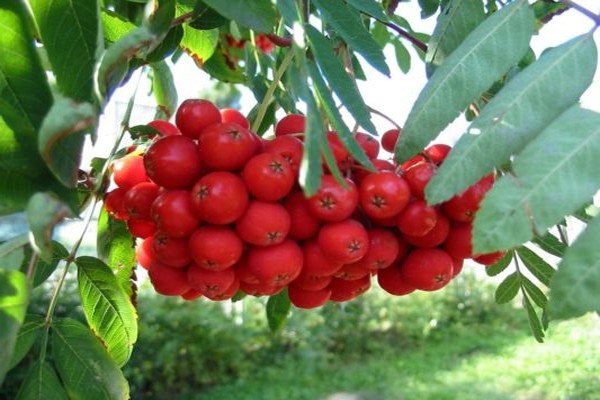

In the future, over the course of three, four years, pruning of a young tree will be moderate. So, it will be necessary to cut out new shoots located close to the ground, branches that grow inside the crown, as well as shoots affected by diseases or pests. It is important not to rush to prune branches that develop parallel to the center conductor. In some cases, they develop and grow faster, therefore, they may well be left in case it is necessary to replace the center conductor.
Intensive pruning of a young tree is not carried out also for the reason that it entails a decrease in the number of flower buds, and, therefore, a low yield of the tree.
Some gardeners prefer to postpone pruning saplings in order to harvest the berries. This is possible when the plant is planted in fertile soil and its moderate moisture is provided. Branches growing at an acute angle should not be cut, they are carefully bent and fixed in the desired position. As a result, the harvest from a two-year-old seedling can be harvested the next year after planting.
Pruning a mature tree that is more than five years old is more time consuming. In order to rejuvenate the tree, side branches are removed, those that have ceased to bear fruit, or bring an insignificant harvest. The old branches are shortened significantly - by a meter, one and a half, thus stimulating the emergence of new young shoots. No more than a third of the old branches must be pruned, otherwise it will negatively affect the yield of the tree. Also, branches that are more than four years old are completely cut off.
Pruning of mature trees begins with the largest and thickest branches of the crown. Removing them will also contribute to uniform illumination of the entire tree. If there is a need to reduce the height of the crown, the upper part can be cut off. Some gardeners cut the crown off each year because it is much easier to maintain and remove berries from a short tree.
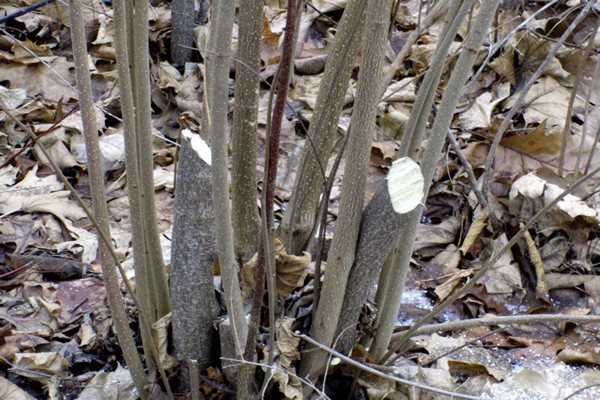

After removing the large branches, they proceed to pruning small branches. Cut branches growing inside the crown, intersecting, located close to each other.
After such a pruning of the crown, the mountain ash will noticeably thin out. However, during the summer period, the tree will quickly gain green mass and restore its decorative appearance.
The growing popularity among gardeners is gaining such a way of forming a tree as pruning mountain ash according to the principle of a dwarf pyramid. As a result of such pruning, the crown of the tree becomes like a Christmas tree. This method of crown formation is also called a spindle. It is especially recommended by specialists for fruit trees such as pear, apple, plum and cherry. This pruning principle allows you to reduce the size of the crown and, thereby, place more trees on the site. For this reason, it is in great demand in industrial horticulture.
Pruning according to this principle is carried out as follows. First, the upper part of the trunk is shortened so that the distance to the upper branches is no more than 40 cm. It is necessary to cut the branch above the bud, placing the cutting tool diagonally. Then a stem is formed by removing those branches that grow at a height of less than 50 cm from the soil surface. Lateral shoots are shortened, approximately by one fourth. The exception, of course, are branches that have any damage.
The next pruning option, also on the principle of a dwarf pyramid, is aimed at stimulating the growth of lateral branches. In this case, the distance from the top to the first branch is no more than 20 cm. From the bottom of the trunk, all branches growing at a height of less than 50 cm from the soil are also removed. In order to activate the growth of lateral shoots, the tree is cut at a height of 90 cm from the ground. In late May - early June, pegs are installed along the perimeter of the crown. Then, the side branches are exposed at the desired angle and tied to the pegs. In order for the branches to quickly form the correct angle, from mid-June to the end of summer on the shoots, the length of which is 40-50 cm and additional weights of 200-300 grams are hung. Formative pruning continues for the next two years.
It should be noted that a tree formed according to this principle has a good yield and can withstand heavy loads.
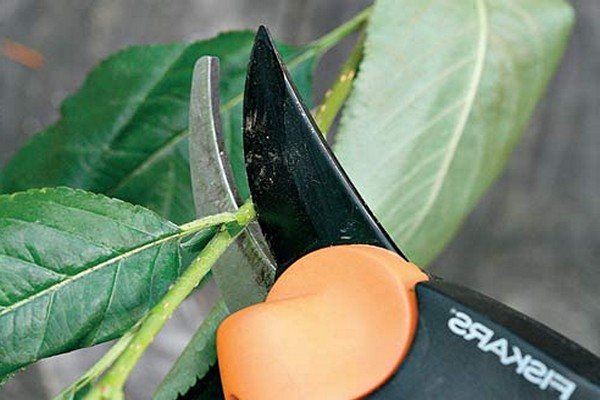

How to plant seedlings correctly
The preparation of the substrate and the planting pit must be done in advance, optimally - 2 months in advance. During this period, the soil mixture will absorb the nutrients necessary for the subsequent development of the culture. The dimensions of the landing pit are 60 * 60 * 50.
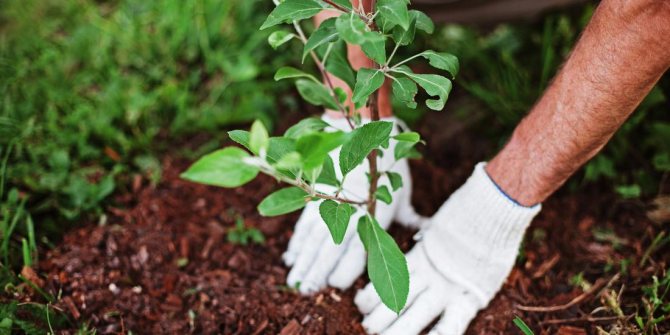

Rowan planting
Growing and caring for leeks in Siberia
The top layer of soil from the pit must be mixed with 120 g of superphosphate, 60 g of potassium sulfate and 2 buckets of compost or humus. Sprinkle the bottom of the hole with a drainage layer (broken brick or crushed stone). Before planting trees, they need to be examined. If damaged roots are found, they must be cut off. If the roots are dry, the tree should be placed in a container of water for 10 hours.
Important! To provide the mountain ash with good survival and growth, it must be planted at a greater depth than the one in which it grew in the nursery. Basal shoots growing on the root collar should be well buried.
If the soil is light, the seedlings should be buried 7 cm, and if the soil is heavy, 3-4 cm. After the soil has settled, the root collar should be 3 cm below the ground surface. Based on the recommended criteria, a mound must be formed at the bottom of the hole, using a prepared substrate for this. Then evenly distribute the roots of the seedlings, avoiding unnatural bending of the roots, otherwise they may turn yellow and die.
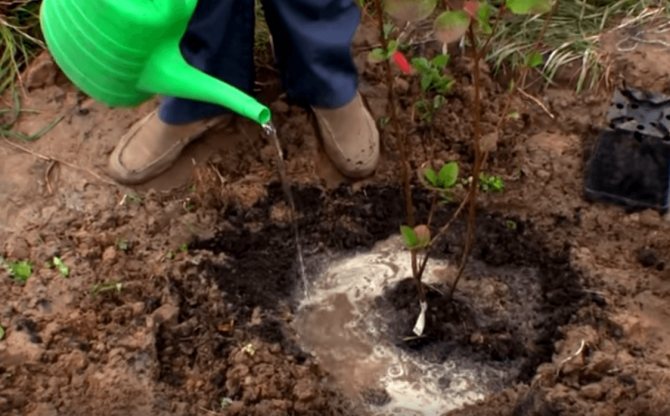

Rowan watering
The trunk circle must be compacted, and the seedlings should be watered abundantly. For mulching, you can use wood chips, cut grass, sawdust or peat. The final stage will be pruning the above-ground part of the seedlings after planting, during which you need to leave no more than 25 cm of the length of the branches.
Bush rejuvenation
Taking advantage of the unpretentiousness of the chokeberry, gardeners often do not pay attention to it. And, if the basal shoots are removed from time to time, then attention is paid to the age of the branches only when the quantity and quality of the crop is noticeably reduced. In such cases, the plant needs radical pruning. It helps to direct all forces to the formation of a young shrub and not to spend them on maintaining old branches.
During this rejuvenation, the plant is cut completely at the soil level. Next spring, young shoots will begin to grow from the root, from which the formation of a new, young plant will begin. The strong root system of the chokeberry will allow in three years to completely revive the bush and again receive vitamin yields.
Follow-up care of the culture
Requirements for the care and cultivation of chokeberry are minimal. Seedlings planted in the fall must be carefully prepared for wintering. To do this, they are covered with spruce branches, and if the winter is not very snowy, it can be covered with snow.
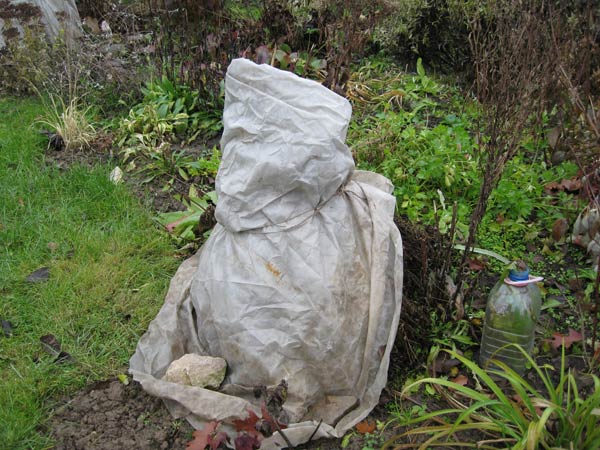

Preparing for winter
Chokeberry rapidly forms shoots, so its crown thickens strongly. Root shoots of young shrubs should be removed and opened only those that have the correct direction of growth and a healthy appearance. In the process of preventive pruning, it is recommended to remove rotten, bare and old branches.
Note! The shrub has the peculiarity of laying fruit buds on annual shoots, so they do not need to be shortened.
Rowan is a moisture-loving crop, therefore, it must be watered throughout the growing season, as well as during the formation of fruits. If the weather is hot, the plant will need watering every 7 days. Twice throughout the season, it is imperative to loosen the soil near the trunk circle, remove weeds.
Timing of pruning.
Depending on the age of the tree, as well as the goals of pruning, the timing of its implementation is different.
So, the pruning of young mountain ash is advised to be carried out immediately after planting, in the first place it is important for the formation of the crown.
Pruning of mature trees is preferable during the summer season. In this case, the cuts made are tightened much faster, which reduces the risk of contamination of rowan with various viruses, infections that affect wood tissue and tree bark. Practicing gardeners also note that summer pruning is more effective than when it is carried out in the spring.
Experts advise pruning rowan trees in good weather, on a warm and dry day, since there is a high probability of avoiding infection of the tree with fungal infections, which spread rather quickly in conditions of high humidity.
After pruning, it is necessary to immediately process the cuts using garden varnish or water-based paint. Some gardeners additionally apply fungicide solutions to the sections. If the cut is not processed, it is fraught with infection with various infections, which in the future can provoke tree necrosis and its death. In order for the cut to tighten faster, it is important that it is even and smooth.


Most often, the following scheme is used to trim rowan. The lower tier of branches is cut so that the height of the trunk is 30 - 60 cm. The pruning is carried out on a ring, that is, almost to the base, or, more precisely, to an influx of annular shape. If necessary, the skeletal branches are pruned, subordinating them to the guide and equalizing with other branches. The central tree conductor should rise 25-30 cm above the upper tier of the branches.
Annual tree pruning involves cutting off unnecessary shoots, young shoots, removing old branches that are no longer fruiting, but only hinder the development of the tree by taking food.
In the autumn season, mountain ash requires more care, involving the adoption of preventive measures to prevent diseases, as well as aimed at increasing yields in the next season. Rowan, like most trees, grows more actively in the spring, and in the summer, its growth slows down a little. Starting in September, the mountain ash gradually plunges into a state of dormancy, which finally comes in November. In the fall, it is not recommended to feed mountain ash with nitrogen-containing fertilizers, since their action is aimed at the growth of the green mass, and before the imminent onset of the dormant period, this is useless. During this period, pruning of mountain ash is also not desirable, since such a procedure will also contribute to the growth and development of the tree. In addition, the cuts made during the autumn pruning do not have time to quickly tighten, and the tree may freeze out.
When the winter is warm and severe cold weather is no longer expected, you can start trimming rowan in February. However, in this case, she will be very moderate and gentle. Such pruning can be applied to two or four year old trees. Pruning of younger, as well as older trees, it is better to leave at the end of spring - early summer. In a number of regions, towards the end of winter, pruning of other fruit trees, such as apple, pear, is also begun, and after a while apricot, plum and peach are pruned.
Some varieties of mountain ash are very vulnerable to various diseases, so they are recommended to be pruned exclusively in summer.
Where is the plant used
The beneficial fruits of chokeberry can be consumed both fresh and made into juice that can stop bleeding, fight hypertension and anacid gastritis. You can also make wine from berries, which is distinguished by its useful qualities, and jam, which can be enjoyed in winter. If you combine the juice and fresh fruits of chokeberry with rose hips, black currants and honey, you can effectively fight burns on the body and lower blood pressure.
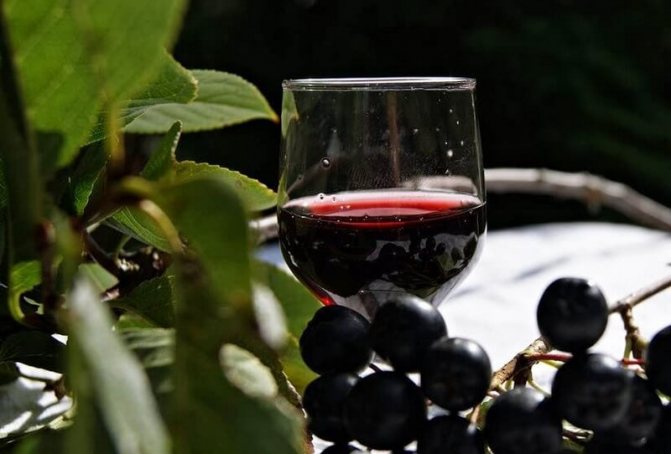

Chokeberry juice
It is worth noting that contraindications to the use of chokeberry fruits are diseases such as varicose veins, gastritis with an increased level of acidity and gastric ulcer.
Due to its decorative properties, the shrub can act as a decoration for a garden or a hedge in a personal plot. Throughout its flowering, the plant will certainly attract the eyes with white inflorescences, and with the onset of autumn, the color of the foliage will turn purple.
What is it for?
Aronia, or as it is sometimes called black chokeberry, is a shrub, so you should not be surprised at the large amount of annual growth. New shoots, expanding, fill a significant area, increasing the base of the bush. To avoid shading, adult branches tend upward, sometimes reaching a height of more than 3 meters. At the same time, the growing shoots develop further, thereby causing the crown to thicken. If you do not interfere with this process, then after two or three years the fruiting of such a bush is noticeably reduced and, at best, only external branches that will receive a sufficient amount of sunlight will bloom and bear fruit. But ripe berries will also be small and not juicy, because the nutrients are consumed by the huge green mass of the plant.
Similar problems with the yield of chokeberry are typical for old, as well as for neglected, "feral" shrubs. Only timely and regular care will help keep the plant healthy. It should be remembered that the most fruitful branches are those aged from 5 to 8 years, therefore, simultaneously with pruning, plant rejuvenation is often carried out.
Diseases and pests
In order for the chokeberry to quickly start growing with the onset of spring, it is recommended to prevent diseases and pests in the fall.
- In order to prevent moniliosis, septoria and peripheral wood rot, mountain ash is sprayed with a one percent Bordeaux mixture or copper oxychloride.
- In the fight against a fungal disease called a comb, the plant is sprayed with the same Bordeaux mixture and severely affected branches are cut off.
- Mountain ash moth and cherry slimy sawfly are insects that harm the fruits and leaves of mountain ash. Thorough harvesting will help to protect the plant from the attack of pests next year: near the mountain ash, dried leaves are raked and burned. Together with organic waste, most of the pupae hiding for the winter are destroyed.
- You can get rid of brown or red ticks by spraying rowan with "Karbofos", "Tedion", "Kleschevit" or other preparations designed to fight insects.
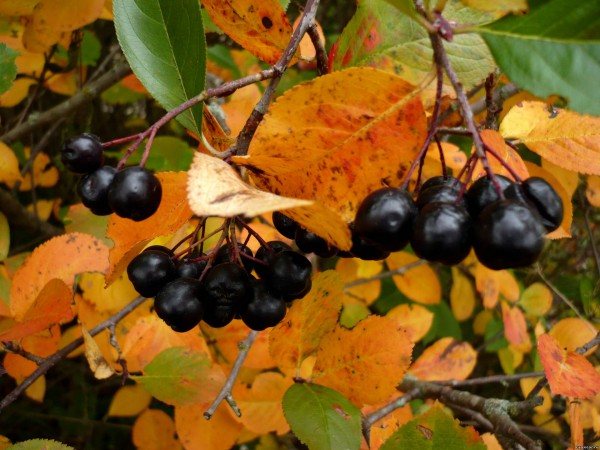

What does rowan look like in spring. Rowan: the most popular species and varieties
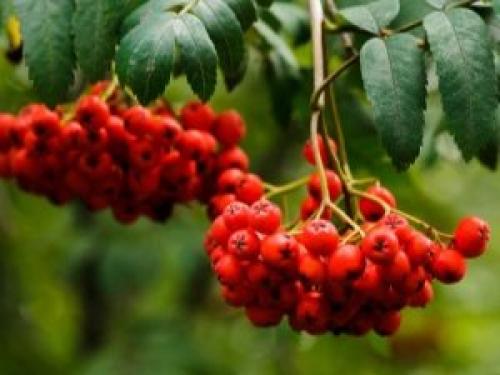

Rowan is a very unusual tree. It has a lot of positive qualities, so many gardeners will definitely plant it in their garden. Due to the ability to be beautiful not only with flowering branches, but also with ripe bunches, mountain ash is often used to decorate the landscape. And the ancient Slavs considered it to be a talisman against evil spirits.
Plant features
Rowan is a fruit tree or shrub that is well remembered for its vibrant fruits. Its growth can reach 10-20 meters. It is good not only for berries, but also for wood, which is distinguished by its strength and elasticity. In the past, it served as a raw material for the manufacture of tableware, shuttles for looms, handles for tools and axles for carts. To this day, bush shoots are a material for weaving pieces of furniture and various accessories.
Rowan blossoms are accompanied by the arrival of a swarm of bees, which collect fragrant pollen. Bees make reddish honey from it with a pleasant aroma. Rowan planting is especially important for beekeeping when, for some reason, linden and willow honey collection failed.
Rowan trees used to help villagers set the timing of agricultural work and even determine the weather. It was believed that multiple pregnancy foreshadowed a rainy autumn and a frosty winter.
It is interesting that in the old days this cultivated plant was endowed with mystical power, which was designed to protect people from any negative influences. In order to protect the newlyweds from damage and the evil eye, rowan leaves were placed in the shoes of the bride and groom, and the berries were hidden in pockets. And with the help of a necklace made of fruits, they protected small children.
Seed propagation
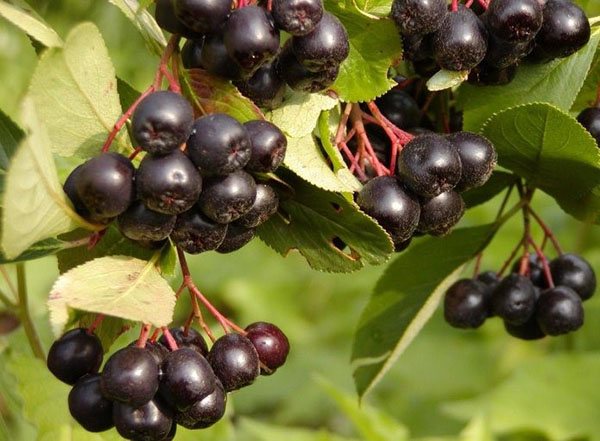

Aronia grains can be bought in a specialized store or prepared by yourself. To do this, ripe berries are thoroughly ground with the help of sated, and then washed under running water.
For better germination, it is recommended to stratify the grains before planting.
The prepared planting material is placed at a shallow depth in the nutrient soil. After the procedure, the garden bed is mulched with humus.
Only the emerging seedlings need to be watered abundantly and often. They are transplanted to a permanent place only for the next fall.
Growing methods
You can grow chokeberry:
- from seeds,
- with the help of cuttings,
- from root offspring,
- by dividing the bush or layering,
- using a graft on a rowan ordinary.
In the gardens of the Moscow Region, the most effective and reliable way will be to plant seedlings. It is recommended to purchase them in nearby nurseries, so that young plants are already adapted to local climatic conditions and quickly get used to a new growing place. This moment should be one of the main ones when purchasing seedlings.
Description
Rowan is a frost-resistant shade-tolerant tree or shrub of the Rosaceae family, it grows up to 10 m, the crown width reaches 6 m. The root system is powerful, penetrates deep into the soil. The rowan has been living for over a hundred years. The tree is decorated with complex-elongated leathery leaves, which consist of small pointed leaves: bright green in summer, yellow-crimson in autumn. In late spring, the tree is adorned with bouquets of fragrant pink-white or cream flowers. And from the middle of summer to the end of winter - orange-red bunches of berries. The fruits are astringent, sweet and sour, with a bitter aftertaste, rich in vitamins and microelements.
The berries are harvested in August and September. Jam, jams, various desserts are prepared from the fruits. Rowan is widely used as a medicinal plant.
How to feed black chops in autumn
After fruiting, the culture needs rest and replenishment. Top dressing of chokeberry in autumn can influence the harvest of the next season.
After harvesting, it is useful to charge the soil under each chokeberry bush by adding 500 g of wood ash and about 200 g of superphosphate. It is good to carry out foliar feeding with a solution of urea (7%). Spraying branches with a nitrogen composition is not contraindicated in the fall and is a prophylaxis against infections.
During this period, it is important not to abuse nitrogen fertilizers applied to the soil. Such dressings in the second half of summer stimulate the growth of the aerial part, the shoots “grow fat”, the bark does not ripen on them. In the fall, you should not fertilize chokeberry with nitrogen.
You can mulch the soil for the winter with peat or humus, which will become additional support for the root system.
When to prune chokeberry
Fig. 42. Formation of a chokeberry bush: 1 - removal of a weak branch; 2 - shortening a strong branch; 3 - growth of branches next year
Fig. 43. Rejuvenation of the chokeberry bush: 1 - old bush; 2 - radical pruning
Many gardeners call the plants of this culture chokeberry. It is possible, of course, but only it is not true. The rowan belongs to the genus Sorbus, and the chokeberry forms its own genus, Aronia.
It is better not to offend either one or the other and call each one by its own name.
Black chokeberry by nature is a typical shrub. It grows strongly from a young age. A lot of growth appears from the root. Let me - 50, or even more branches will be in the bush. Its foundation will expand. And the branches will go in height, overtaking one another. The three-meter mark has been crossed. The crown will thicken. Fruiting will move to the periphery - to an area of good lighting. Inside it will become empty. The yield of fruits per unit area will be small.
To prevent this from happening, take control of the situation. But don't force the plant. Don't force it to grow like a tree. Let it remain a bush, but adjust the number of branches and the strength of their growth as you need and convenient. Make sure that the branches are always young, strong; so that no shading is created; so that the whole crown was saturated with fruits, and not only its top and a little periphery. All pruning work should be done in the spring.
Preparing for winter
Chokeberry is a cold-resistant crop, in most regions it tolerates winter without special shelters. Additional measures of agricultural technology are designed to help the chokeberry get out of winter dormancy strong, grow quickly, and in the fall give a high yield of useful berries.
Pre-winter black choke care:
- Moisturizing. If autumn is dry, chokeberry will need only one, but abundant watering. Under an adult plant, from 20 to 40 liters of water are introduced, within the projection of the crown.
- Loosening and mulching retain moisture and ensure proper breathing of the roots. A covering layer of 5-10 cm will protect them from freezing during changeable weather.
- Spruce branches, used as shelter, or mulch made from coniferous needles scare away rodents.


In the conditions of harsh winters, even adult chokeberry bushes need shelter. For a frost-resistant culture, it is enough to bend to the ground with an arc of up to 20 cm. For this, wooden shields, heavy tree branches are used. The fallen snow reliably keeps the blackberry from freezing. If there is little precipitation, the plants are covered with earth or leaves.
Seat selection
Tall varieties are placed around the perimeter of the site, otherwise the tree will shade other plants. Since mountain ash is winter-hardy, the northern side is often allocated for it.
The plant tolerates shade and sun equally well, loves wet areas, but the occurrence of groundwater should not exceed 1 m.
The best soil for mountain ash is a fertile loam that retains water for a long time, although the tree also grows on less nutritious soils. It develops poorly on alkaline soil, sandy loam must be fertilized. Acidic soils alkalize - you will need from 200 g to 1 kg of lime or dolomite flour.
Rowan transplant
You can not only plant rowan in the same place, but also transplant. But you can only transplant a plant that is no more than five years old. In principle, the transplant and the initial landing are carried out in the same way. Still, mature trees can be transplanted, but this will be much more difficult. This is best done in late autumn, when the tree is already at rest. Outside at this time, the temperature should already be from 0 to -15 degrees, but not lower. The tree you are replanting must be at least three meters long. Digging up a tree will be difficult, but you need to do it carefully. All long and large roots must be pruned before transplanting. But the earthen lump that was on the roots must necessarily remain during transplantation. The planting hole should be half a meter wider than the diameter of the roots together with the ground. At the bottom of the pit, it is imperative to lay a drainage layer. After planting, the earth is tamped and watered. In general, autumn planting is the most optimal time for planting mountain ash. At this time, it takes root well and easily tolerates winter frosts. Since the autumn moisture will be enough for it, the gardener will not have to waste his energy on watering the plant.A tree planted in autumn will have immunity several times higher than that of a tree planted in spring, and in its development during autumn planting, mountain ash is ahead of spring, and accordingly it will give a harvest earlier. In general, you don't have to take much care of the mountain ash, the main thing is that initially you chose the right seedling, prepared and planted it according to all the rules. The whole future development and yield of this wonderful tree depends on planting. In principle, if you initially did something wrong or did not choose the right place, then the mountain ash can be transplanted, but at the same time all previous mistakes must be corrected. In general, mountain ash can grow on your site for several decades and it bears fruit almost constantly, delighting all lovers of this very useful berry with a huge number of fruits.
Rejuvenating sea buckthorn bush pruning


Sea buckthorn in the photo
Pruning of sea buckthorn is mainly sanitary; it is also necessary to remove root suckers in a timely manner. If you do not pay attention to them, instead of two or three trees you will get a real “grove” in record time, from which it will be extremely difficult to get rid of.
Sea buckthorn is a dioecious plant, and it is impossible to change the floor of the tree by cutting. Male plants are distinguished by "promising" large buds, which is sometimes used by unscrupulous sellers. Sea buckthorn gives good yields when there are 5-6 female plants in the "harem" of one male plant. If there is not enough space for several trees, you can graft a twig of a male plant into the crown of a female one. There are varieties of sea buckthorn that differ in the height of the tree, the size of the fruits and their shades - from light orange to almost red, and theoretically, from the sea buckthorn, as well as from the apple tree, it is possible to make a "garden tree".
When placing sea buckthorn in the garden, remember that it is a wind-pollinated plant, and for good fruit setting, the crown must be blown by the wind. In crowded conditions, one cannot count on high yields.
This shrub is prone to thickening and bare branches. Therefore, you will need a rejuvenating pruning of sea buckthorn, for beginners it is advisable to combine thinning with harvesting, cutting out some of the branches with fruits and "plucking" them at home, in a calm atmosphere.
Sea buckthorn fruits are preserved on the branches after leaf fall and even in winter. However, it is necessary to think about protecting the crop from birds, sometimes blackbirds and waxwings arrive already in September.
Watch the video "sea buckthorn pruning" to better understand how to perform this responsible event:
How to prune chokeberry and sea buckthorn


Both chokeberry and sea buckthorn are quite tall shrubs. Therefore, when pruning chokeberry, as in the rejuvenating pruning of sea buckthorn, you cannot do without a stepladder. To give the bushes a neat shape, it is recommended to shorten the branches at approximately the same height. Cutting sea buckthorn, like chokeberry, is necessary so that air currents freely penetrate into the crown for better pollination and airing the bush.
Why do you have to cut rowan in the fall
Professional gardeners recommend pruning most shrubs in early spring, before sap begins to flow in the plants. Usually this period falls on March or early April, that is, what is also called the snow. But just not everyone has the opportunity to visit their garden at this time. On the other hand, at the beginning of spring, and without this, there is enough trouble and often postponing pruning, the right moment is missed. In this case, you do not need to grab the pruner and complete the work in the fall, otherwise the loss of moisture through the open wounds of the cut branches can be detrimental to the plant.
Removal of chokeberry shoots, which appears at the base of the bush, is carried out throughout the season, and it is completely painless for the plant.

